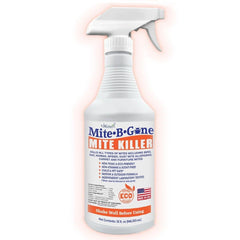Mites aren’t just a nuisance for us humans; they can also make our furry friends uncomfortable and affect their health. Whether it’s ear mites, mange mites, or other types, these tiny pests can lead to severe itching, hair loss, and even secondary infections if left untreated. Today, we will explore the common types of mites that have it in for your pets, how to recognize the signs of infestation, and explore a few ways to keep your pets safe.
3 Common Types of Mites That Affect Pets
- Ear Mites (Otodectes cynotis)
Ear mites are one of the most common types of mites that affect pets, particularly cats, but dogs can also be affected. These mites live in the ear canal, where they feed on ear wax and skin oils.
The most noticeable signs of an ear mite infestation are intense itching and head shaking. You may also notice a dark, crumbly discharge resembling coffee grounds in your pet’s ears, which is a mix of ear wax, blood, and mite debris. If you notice these things, get your pet to the vet for treatment and regularly clean their ears to prevent re-infestation.
- Sarcoptic Mange Mites (Sarcoptes scabiei)
Sarcoptic mange, also known as scabies, is caused by the Sarcoptes scabiei mite. These mites burrow into the skin, causing intense itching and an awful rash. Dogs are most commonly affected, but other animals and even humans can be infected, too.
The tell-tale signs of scabies include severe itching, hair loss, red and inflamed skin, and scabs. Treatment usually involves topical or oral medications, so you need to take your pet to the vet. You also need to treat your home with effective sprays and give it a thorough clean.
- Demodex Mites (Demodex spp.)
Demodex mites are normally found in small numbers on healthy pets living in hair follicles and sebaceous glands. However, if your pet’s immune system is compromised, these mites can multiply and cause a condition known as demodectic mange.
Signs of demodectic mange include hair loss, particularly around the eyes and muzzle, red and inflamed skin, and, in severe cases, secondary bacterial infections. Treatment for this often includes medicated shampoo, oral medications, or dips, so you have to consult with your vet.
How to Prevent Mite Infestations in Pets
Now that you know what symptoms to watch out for (hair loss, inflammation, itching, scabs, etc.), let’s talk about prevention. One of the best ways to prevent infestation is to keep up with your pet’s regular grooming needs. Make sure to brush their coat regularly to remove the dead skin cells Mites love so much. This will also give you the chance to spot symptoms early on!
Regular baths with a mild pet shampoo are also a must. This will reduce the likelihood of mite infestations! If your pet has skin issues, make sure you use whatever shampoos your vet has prescribed. Ear cleaning is also essential, and you can’t skip it. Do this gently, and use a good ear cleaner! You also need to keep up with health checkups for your pet, so don’t miss any vet appointments.
Last but not least, you need to keep your home clean because mites can easily spread from the environment to your pet. Regularly wash your pet’s bedding, vacuum carpets, and furniture, and keep living areas free from dust and debris. Also, consider using non-toxic mite sprays to treat areas where mites might be present.
My Pet Already Has Mites; What Now?
If you suspect your pet is already infested or you’ve spotted the signs already, don’t fret. The first thing you need to do is take them to the vet as soon as possible. The earlier a mite infestation is diagnosed, the better. Once you get your pet’s treatment, make sure to follow it to a tee. Whether treatment involves oral medication, cleaning your pet’s environment, topical treatments, etc., be very diligent about it.
Once you get things under control and your pet is free of mites, keep a close eye on your pet for a while. Then, make sure to prevent re-infestation by considering the tips we shared above!
Mites can cause serious discomfort for pets with all that itching, hair loss, and other health issues. By recognizing the signs of mite infestations and taking preventive measures, you can protect your furry friends and keep them healthy and happy. Regular grooming, a clean environment, and a good pet-safe mite spray can go a long way!






